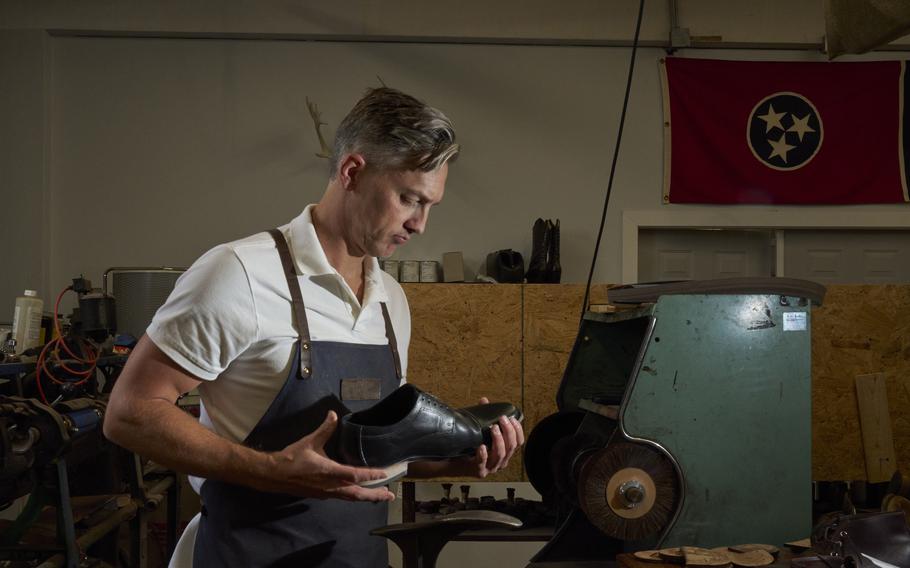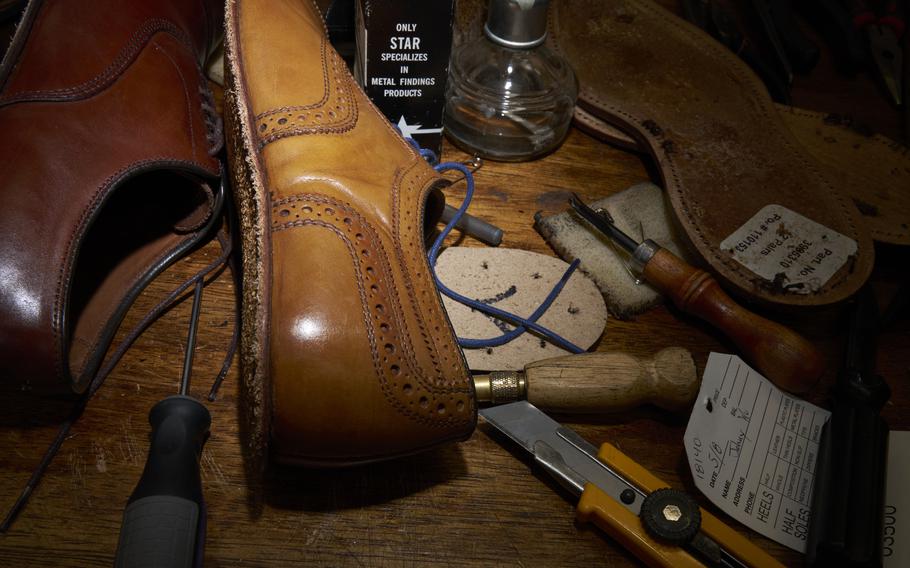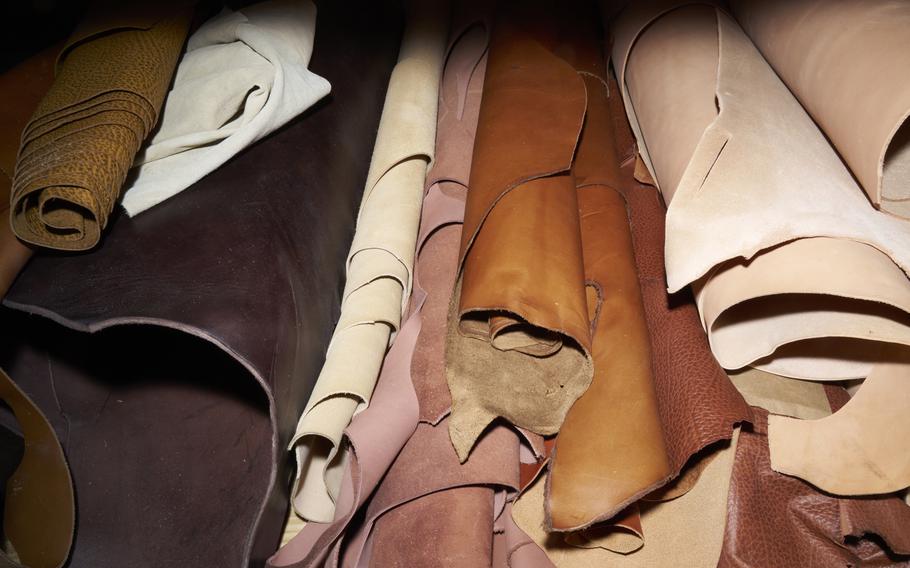
Heath Potter at work at his shoe repair business with the Tennessee state flag on the wall. Heath and his brother Trenton co-own the business as well as a sandal brand, Southern Polished, in Tennessee. (Photo for The Washington Post by Stacy Kranitz)
In shoe making, there’s an old, proud tradition of crafting stacked leather heels, a meticulous process that involves laying strips of leather on top of one another until they hit the desired height. But when a pair of luxury Saint Laurent boots arrived at Trenton and Heath Potter’s shoe repair business, the brothers saw evidence of a different technique: The boot’s block heel, which looked like stacked leather, was in fact made of hollow plastic, disguised by a thin veneer.
Trenton Potter, a Nashville-based cobbler who co-owns the business and a sandal brand with his brother, says this sleight of hand is not uncommon for brands.
“There are a number of very high-end designer brands that will charge you $800 or $1,000 for a pair of shoes, and they’re all just glued together,” he says. “It’s almost like wallpaper. They’re not great quality. You’re just paying for that designer brand.”
Potter has long observed a decline in quality among popular shoe brands as companies continue to outsource manufacturing, cut costs and churn out new styles. A good pair of shoes should come at a cost — Potter puts the minimum price for high-quality men’s shoes in a traditional style at $300 — but they should also last at least a decade with proper maintenance. Those numbers will sound alien to many of today’s shoppers, judging by a survey by the Footwear Distributors and Retailers of America that found the majority of people say that for shoes to be considered durable, they need to hold up only for two years.
For women, finding good shoes is even tougher because, experts say, brands operate on the assumption that women buy many pairs and will prioritize style over durability or comfort — although it’s impossible to say whether brands have deprioritized quality to meet customers’ low expectations or if customers have adjusted their expectations in response to declining quality. The process becomes more complicated when buying shoes online, without the benefit of trying them on or even examining them up close.
Assuming that customers do indeed want a “well-made” shoe, how would they even go about finding one? Putting aside sneakers, experts offer tips on what to look for in common styles such as dress shoes, boots and heels:

Shoes in the Potters’ repair workshop in Tennessee. Co-owner Trenton Potter has long observed a decline in quality among popular shoe brands as companies continue to outsource manufacturing, cut costs and churn out new styles. (Photo for The Washington Post by Stacy Kranitz)
Construction
Shoes have three basic elements: the sole, which touches the ground; the insole, which you step in; and the upper, which is the part that wraps around your foot. How these elements are held together has a big influence on how the shoe will perform. Gluing is a cheaper and easier method than stitching, but glue also comes apart more easily, especially when exposed to high heat.
“I cannot begin to tell you how many people bring ladies’ sandals into our shop after one of the straps has come unglued,” Potter says.
The overwhelming majority of women’s footwear is made using only glue, says Potter, with some exceptions, such as the Office of Angela Scott, which stitches its shoes with methods mostly only used in men’s shoes (although this is reflected in the price tag, with most styles starting at $400).
Higher-quality men’s dress shoes are often stitched together with the Goodyear welt. This method allows a pair of shoes to be resoled multiple times without damaging the upper portion of the shoes. Shoes made this way are durable and water-resistant, although they may take longer to break in. Another method, the Blake stitch, uses a special machine to stitch the upper and lining straight through the sole. These may be a bit easier to break in, but they won’t be quite as water-resistant.
While it is hard to tell exactly how a shoe is constructed just by looking at it, Potter advises examining the sole and insole. If you can’t see any stitching, it’s probably glued together. You could also ask the salesperson about the make, or read the product notes online for details.
Meghan Cleary, a writer and shoe expert, advises that when shopping online, you pay less attention to social media influencers — who might have been paid to promote a brand — and spend more time reading customer reviews.
“Digging a bit deeper and scrolling down can help you home in on specifics and potential problems,” she says. “Look for comments that are detail-oriented, like, ‘the material felt amazing on my foot,’ or ‘I walked all day and didn’t get a blister,’ or, on the negative side, ‘these were too tight.’”
When buying shoes in person, experts say, you should examine them for imperfections: glue coming off between the heel and the upper, ragged edges that are not trimmed neatly, or stitching that is a little untidy.
Susannah Davda, a shoe consultant in London, advises placing high heels on a flat surface to see if they wobble. “If you tap the side of the shoe and it does quite a lot of wobbling, that’s exactly what your body is going to do when wearing them,” Davda says.
She says that it’s common for companies to put padding in high-heeled shoes so they seem more comfortable but that shoppers should be skeptical: “Not all padding is made the same. Some padding compresses very easily, so it’s more of a marketing tool than it is something that’s going to give you long-term comfort. At the same time, some thin padding is still effective.”
You can test this by pressing your thumb inside the shoe to see whether there’s resistance. If you can easily push down and feel the sole underneath, that’s not a great sign.

Rolls of leather for making sandals at Southern Polished in Tennessee. Natural leather is associated with high quality because it is pliable, breathable and molds to the foot. However, leather soles are generally less durable than synthetic ones. (Photo for The Washington Post by Stacy Kranitz)
Materials
Natural leather is associated with high quality because it is pliable, breathable and molds to the foot. If you want nice leather shoes without doing a lot of research, you can be pretty confident in opting for a “Made in Italy” label with “Vero Cuoio” (meaning real or true leather) printed on the sole, says David Ulan, a senior instructor at the Fashion Institute of Technology in New York.
But leather soles are generally less durable than synthetic ones, Ulan says, so your personal preferences play a role in which material is superior. If you want more cushion or grip in a sole, you might opt for something made of rubber, Cleary says.
For those with ethical qualms about animal products, there are synthetic alternatives such as polyurethane (PU). However, if sustainable production is your priority, note that PU is primarily derived from fossil fuels. If you’re not married to the aesthetic of leather, you can look to fiber materials. Cleary points to brands such as Vivaia, which sells pairs for under $100 that are made from various synthetic materials, including hemp and recycled plastic bottles. For a sustainable, high-quality leather alternative, Nicoline van Enter, the chief executive and a founder at Footwearlogy LAB, recommends shoes made with MIRUM — a plant-based, plastic-free material..
Fit
Of course, it doesn’t matter how well-designed a shoe is if it doesn’t fit. Tacey Powers, the executive vice president and general merchandise manager for shoes at Nordstrom, urges shoppers to get fitted by a salesperson.
“Have them measure both of your feet,” Powers says. She says it’s not uncommon to find that one foot is slightly larger than the other. If so, you may want to buy a “split-sized” pair, which Nordstrom offers, in which one shoe is a half-size larger than the other. And if your feet measure wide, look for a size marked as such.
Fit starts early in the design process with a “last” — a three-dimensional form around which a shoe is constructed. Lasts are unique to a particular company and often are used for many styles, even those that look very different to shoppers, Powers says.
Sticking with the same brand doesn’t necessarily mean you’ll be getting shoes made with the same last. But Powers shares an insider tip: Brands often give shoes a name (think “Beverly” or “Bianca”), and styles whose name start with the same letter are often made with the same last. If you find one pair within a brand that fits you well, look for other styles with names that share the same letter.
Selecting and caring for the right pair
Potter suggests sticking with shoemakers that have been around for a century or more, or finding a vintage pair from a legacy brand. Potter has seen customers find great pairs on eBay or at thrift stores and bring them to their shop for restoration.
No matter where you get your shoes, taking good care of them will make them last much longer. Potter thinks of it as maintaining a car: If you never fix it or get your oil changed, it’ll be much more likely to break down. Condition the leather to keep it supple, place cedar shoe trees in shoes to absorb moisture and take shoes to a cobbler when you see signs of wear.
Ultimately, van Ender says, when it comes to buying shoes that you’ll keep, the challenge has more to do with knowing yourself. She works with companies that recycle footwear and says that at least 80% of the shoes they receive look almost new — suggesting that people are getting rid of them not because they’ve fallen apart but simply because they don’t end up wearing them. She advises scrutinizing the pairs you own and asking yourself why you do or don’t wear them before buying your next pair. Is there a pattern with poor fit in parts of your foot? Do you need to acknowledge that certain styles just aren’t conducive to your lifestyle?
While buying shoes may seem fairly inconsequential, Cleary says it’s not something people should take lightly.
“Shoes have a profound physiological effect on your body, from the moment you put them on,” she says. “They change the way you walk, the way you carry yourself and the way you relate to the world.”